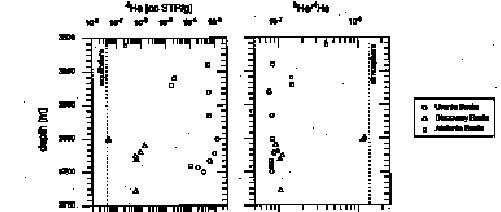
During the first phase of the MEDRIFF Project three lakes of concentrated brines were discovered in the Eastern Mediterranean Sea (MEDRIFF, 1995). The deep basins filled with brines of extraordinary chemical composition are located on the Mediterranean Ridge, southwest of Crete. Samples for noble gas analysis were taken in all three lakes in order to investigate the origin and fluid kinematics of the brines.
Since 1969 the isotopic composition of helium has been proven to be a sensitive geochemical tracer for studying the oceanic circulation and the injection of fluid components into the ocean. One of the main results was the discovery of excess helium characterized by a 3He/4He ratio of 1.2·10-5 (8.5 times the atmospheric 3He/4He ratio) in Pacific waters. This excess 3He has been interpreted as injection of mantle-derived helium into the ocean at mid-ocean ridges. In contrast, injection of radiogenic helium produced by the alpha decay of natural radioactive decay series and characterized by 3He/4He ratios of 2·10-8 to 10-7 has been observed in very few cases so far leading to only slightly enriched 4He concentrations. Similar to radiogenic helium, 40Ar produced by decay of 40K can be accumulated by waters circulating through oceanic sediments.
The 4He concentrations of the samples obtained from the Mediterranean brine lakes are increased by a factor up to 3·104 compared to air-saturated water and reveal 3He/4He ratios between 8·10-8 and 1.5·10-7 clearly indicating a radiogenic source of the helium excess. The data shown in this contribution represent the strongest radiogenic helium excess in oceanic waters reported so far. Comparing the 4He profiles with the 3He/4He profiles it is evident that the highest 4He supersaturations are related to the lowest 3He/4He ratios (Fig 1). Five samples from Urania Basin where the brine with the most distinct helium signature has been found were analyzed for their Ar content and 40Ar/36Ar ratio. The 40Ar/36Ar ratios range between 375 and 470 clearly indicating a radiogenic 40Ar excess of the brine. The accumulation of radiogenic helium and argon in the brine confirms the model that the brines result from dissolution of underlying evaporites by circulating fluids.
The nature of the extreme 4He supersaturations can be determined by considering the isotopic ratio of the excess helium component. Comparing the three basins each brine lake is marked by a typical helium excess component with excess ratios differing significantly from each other. This observation corresponds to the highly different chemical composition of the three brines. Thus, the isotopic data supports the hypothesis that each lake has its own origin and that the brines are derived from selective dissolution of different parts of the Messinian evaporites (MEDRIFF, 1995).
MEDRIFF Consortium, Eos, Trans. AGU 76, 313 (1995).
Fig. 1: Depth profiles of 4He concentration and 3He/4He ratio obtained from the three brine lakes.